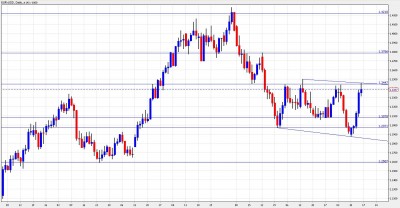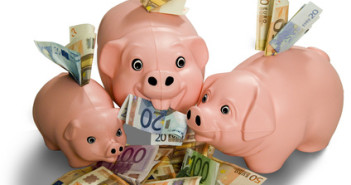EUR/USD made a remarkable recovery in the past week, but it didn’t manage to break above critical resistance. Is this a sign? Or is the common currency taking it step by step? 5 reasons to challenge this rise.
1. Portugal At the beginning of the week, Portugal seemed to be very close to getting a bailout. Then, China and Japan pledged to help the troubled Euro-zone countries. And bond auctions were covered decently. Confidence returning to the old continent?
Not so fast. The yields on these bonds were still high. Portugal managed to raise money, but it still isn’t sustainable.

EUR USD Cannot Break Higher – Click to Enlarge
2. Spain And what about Spain? This domino is too big for the current bailout fund. Germany, which was somewhat hesitant about enlarging the fund, then made it clear at the end of the week, as the finance minister said a clear Nein!
Spanish bond yields on ten year notes eased from 5.50% to 5.33%. Better, but still high, higher than after Trichet began buying bonds, when they fell to 5%. Spain is still in the danger zone.
3. Inflation The Euro got a boost from Jean-Claude Trichet once again, this time on his focus to curb inflation. This isn’t new – also in his previous conference, he boasted that inflation is contained, and that the bank is achieving its goals. Is a rate hike coming soon? Will it boost the Euro?
With the current fragile situation in many countries, a rate hike could destroy any signs of real recovery. The Euro-zone’s unemployment rate is 10.1% – it didn’t go down for a long time. Does the continent really need tightening measures? I believe that Trichet will face pressure not to raise the rates.
4. Weak US figures – One of the main drivers of improvement was an improvement in weekly unemployment claims – and in the past week, there was a big disappointment – 445K. This is back to the previous high range.
But, many experts say this is seasonal. This is still to be seen, but one week’s jump still isn’t a sign. As it was important to wait for more good data to point to an improvement, more bad data is still necessary to prove that this wasn’t seasonal.
5. Technicals EUR/USD managed to retake 1.2970 and 1.3080, two important support lines that turned into resistance after the fall. And indeed, it continued marching forward, moving higher in the previous wide range.
But it stopped short of the critical resistance line of 1.3440 – the line that capped it so many times in the past. A temporary rise above this line was very short lived. We’re still in the same range for almost two months, and even slightly leaning lower. Only when EUR/USD sits comfortably above this level, we can say that the bulls are back in town.
We need more signs to be convinced…
Further reading – EUR/USD – Selling the Pullbacks – Elliot Wave Analysis
